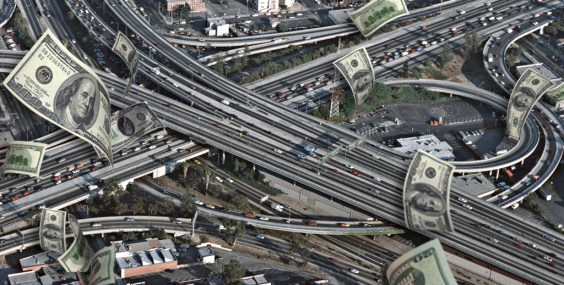 Yesterday, scores of cyclists took to the streets in a memorial ride for the 14 bikers and 134 pedestrians known to have been killed by motor vehicles on the streets of New York City in 2006 (photo, right). I didn't get to go on the ride but I heard from some who did that it was a moving and affirming event. All of the city's major dailies covered it -- headlines below.
Yesterday, scores of cyclists took to the streets in a memorial ride for the 14 bikers and 134 pedestrians known to have been killed by motor vehicles on the streets of New York City in 2006 (photo, right). I didn't get to go on the ride but I heard from some who did that it was a moving and affirming event. All of the city's major dailies covered it -- headlines below.
Times Up and Visual Resistance, the makers of the Ghost Bike memorials, have done a lot of work to raise consciousness about the dangerous conditions that New York City cyclists face on a daily basis. Likewise, here on Streetsblog we spill a lot of ink over motor vehicle carnage. and spend plenty of time and energy publicizing how dangerous it can be to ride a bike in New York City. A recent conversation made me question whether that's a good thing.
My friends Carl and Tia, a husband-and-wife documentary filmmaking team, live in Park Slope and work in a converted warehouse building in the Gowanus. They -- literally -- have bike lanes running door-to-door along the entire one mile route between their home and office. But Carl and Tia walk to work every day. I asked them if they ever thought about biking to work and Tia said it scares her too much. Why?
"I walk past that Ghost Bike on Fifth Avenue every day where that woman was killed," Tia said.
That woman was Elizabeth Padilla and her Ghost Bike is on Fifth Avenue and Prospect Place (photo, below). It is a Ghost Bike that, for all of the good intentions of those who installed it and maintain it (myself included), has convinced at least two people not to commute to work by bike.
 Granted, my two friends do not comprise a scientific sample and there may be others who are inspired to ride by the Ghost Bikes. What science does tell us, however, is that one of the most important bike safety measures of all is safety-in-numbers. As Transportation Alternatives Magazine reported, a mounting body of research conducted in a wide range of cities, intersections, and time periods proves that, as the number of cyclists on the road increases, the chance that a given cyclist will be struck by a motor vehicle decreases.
Granted, my two friends do not comprise a scientific sample and there may be others who are inspired to ride by the Ghost Bikes. What science does tell us, however, is that one of the most important bike safety measures of all is safety-in-numbers. As Transportation Alternatives Magazine reported, a mounting body of research conducted in a wide range of cities, intersections, and time periods proves that, as the number of cyclists on the road increases, the chance that a given cyclist will be struck by a motor vehicle decreases.
The safety-in-numbers rule is also called "P.J.'s Law" after Peter Jacobsen, the California engineer who documented it in the journal, Injury Prevention in 2003. Jacobsen found that doubling the number of cyclists on the road tends to bring about a corresponding one-third reduction in cyclist crashes with motor vehicles. By the same token, tripling the rate of cycling cuts the crash rate in half. In other words, if you want to make cycling twice as safe in New York City, just triple the number of cyclists on the city's streets. Conversely, discouraging people from riding bikes makes a city's streets less safe for all cyclists.
New York City's bicycling advocates have made great headway in the last few years. Last fall a multi-agency task force issued an unprecedented study examining all of the reported bike fatalities and injuries on New York City streets between 1996 and 2003. The city also committed to building out more than 200 miles of new bike lanes in the next three years. For all of the trouble that the NYPD and various individual motorists give cyclists, bike safety issues are clearly moving up on the civic agenda.
With a new year having just arrived, perhaps it is a good moment for bicycling advocates to take a step back and ask what our goals are and whether heavily publicized memorial rides and prominent Ghost Bikes are helping to achieve those goals. Is there a way to advocate for bike safety improvements and acknowledge cyclists' deaths and injuries without sending the message to potential new cyclists that New York City is too dangerous to try biking?
- Bikers Ride To Remember Those Killed by Motorists (NY Sun)
- Cyclists remember riders who died (AMNY)
- Advocates call on city to make streets safe for bikes (Metro)
- NYC cyclists ride for those who died on their bikes in 2006 (SI Live)
- Ride for Fallen '06 Cyclists (NY Post)
- 100 Cyclists Join Tribute (News)
- Manhattan: Memorial Bike Ride (NYT via AP)
Photos: Both photos taken yesterday. DrewVigal on Flickr, Stu_Jo on Flickr





